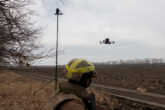March 12, 2018
2019 President's Budget Request for the Navy and Marine Corps
The Department of the Navy’s budget request for 2019, which includes both the Navy and the Marine Corps, increased by just under 8 percent over the 2018 president’s budget request, for a total of $194.1 billion.1 The Navy and Marine Corps will spend much of this increase on additional ships, aircraft, and personnel. The Navy argues that these increases would improve readiness, the lack of which has been cited as one of the factors in 2017’s fatal ship collisions and aviation mishaps. Newer equipment could reduce maintenance requirements; more ships across the same missions could lessen stress on the fleet; and more sailors and Marines could allow more time for training. However, it may not be possible for the Navy to buy its way out of all its readiness problems in this way, even with a budget increase of $14 billion above last year’s original request.
The interactive graphic below provides a view of the Navy and Marine Corps budget request at different levels of aggregation and ultimately down to the program level of detail. Click on budget titles to see a breakdown by category; click on each category to see individual programs. Hover over labels or segments in the chart for additional detail. Click the inner rings to return to higher levels in the chart.
Source box: See endnote 2.2
Ships
As it does every year concurrently with the president’s budget request, the Navy released its “Report to Congress on the Annual Long-Range Plan for Constructing of Naval Vessels for Fiscal Year 2019,” also known as the 30-year ship building plan. Both the budget request and the ship building plan show an increase in the size of the fleet, although the Navy’s stated goal of achieving 355 battle force ships, first announced in December 2016, remains distant – somewhere in the 2050 timeframe with options for accelerating growth to get to 355 ships in the 2030s. The ship building plan is the first of a few areas in the Navy’s budget request where the tension between increasing the capacity of the fleet and the capability of the fleet becomes apparent. Buying less expensive and less capable ships would grow the fleet more quickly, an argument made since the beginning of the Littoral Combat Ship (LCS) program.
Instead, the Navy has chosen to invest in more capable ships, accepting a slower rate of growth. The 2019 30-year ship building plan grows the projected size of the fleet by 11 ships over the 2018 plan, projecting a total of 326 ships in the fleet by 2023.3 The budget requests one additional DDG-51 Arleigh Burke–class destroyer (for a total of three) and one additional T-AO fleet oiler (for a total of two) than the 2018 request. The request reduces the LCS buy from two to one in preparation for transition to the Navy’s next generation frigate program. These Arleigh Burkes offer far more capability than the smaller LCSs, particularly missile defense capability, but they come at about three times the cost per ship.
Further, in light of the evolving threat environment and the strategy’s prioritization of strategic competition with China and Russia, one might have expected to see increased investment in submarines, either along with or instead of some of the growth in the surface fleet. It is no secret that the United States faces increased threats to the surface fleet. At the same time, the U.S. Navy enjoys an advantage in the subsurface domain. But instead of growing the subsurface fleet, the Navy has chosen to sustain the investments made in previous years rather than using some of their additional topline to grow this part of the fleet. The budget request holds the SSN Virginia-class fast attack submarine buy rate steady at two per year. The budget continues plans to replace the current SSBN ballistic missile submarines with new Columbia-class boats, requesting $6 billion in procurement and another $514.8 million in research, development, testing, and evaluation (RDT&E) for this purpose in 2019. In addition, the Navy’s RDT&E budget sustains investment in unmanned undersea vehicles totaling $227.2 million for 2019.
Aviation
Carrier aviation is another area where the Navy’s desire to increase both capacity and capability compete for available resources. Currently the vast majority of Navy strike fighters are 4th generation F/A-18 variants, while the Navy will not deploy its first operational 5th generation F-35C squadron until 2021. The budget request buys more of both aircraft, but favors 4th generation capacity over the additional capabilities of the 5th generation F-35C. The budget requests five more F-35Cs than the Navy asked for in 2018, for a total buy of nine. At the same time, the budget request increases the F/A-18E/F Super Hornet buy from 14 aircraft in 2018 to 24 in 2019. In addition, the Navy is investing in service life extension for many existing Hornets and Super Hornets, running them for 8,000–10,000 hours, as opposed to the original design life of 6,000 hours. End of service life for F/A-18A-D aircraft is challenging carrier aviation capacity; without increased investment, there may not be enough available aircraft to fill out the current carrier air wings. Super Hornets can be had at lower cost than F-35Cs, which we can assume is a key consideration in the Navy’s decision to procure nearly three times as many F/A-18E/Fs as F-35Cs. But the delay getting 5th generation stealth aircraft onto carrier decks, a critical capability in any conflict with any adversary possessing advanced air defenses, seems inconsistent with a strategy that prioritizes strategic competition with China and Russia. On the other hand, the Navy’s budget request also increases the planned P-8A buy by three over the 2018 request, for a total of ten. These aircraft provide anti-submarine warfare capabilities critical to counter both Chinese and Russian undersea operations and replace P-3s that are nearing end of service life.
The Marine Corps continues to buy the short take-off/vertical landing (STOVL) variant of the F-35 at a steady rate of 20 per year. These new F-35Bs are required to replace the Marine Corps’ AV-8B Harriers and F/A-18A-D Hornets, which are at end of their extended service life.
The Navy’s RDT&E request does not contain much that is new in terms of aviation, but it does continue to invest in several significant programs already in development. The request provides $718.9 million for unmanned carrier aviation, including the MQ-25, which will extend the range of carrier-launched aircraft by providing badly needed tanking capacity. Formerly the Unmanned Carrier Launched Airborne Surveillance and Strike (UCLASS), the MQ-25 concept’s focus on refueling is a departure from the Navy’s original plan to develop and unmanned surveillance and strike platform. The Navy also requests $574.8 million to continue development of the next generation jammer, required to keep up with the evolution of electronic warfare – defending U.S. military use of and attacking adversary use of the electromagnetic spectrum. Last but not least, the RDT&E request provides an additional $511.5 million for F-35 continuous capability development and delivery.
Readiness
The increase in the number of ships and aircraft in the Navy previously discussed could improve readiness by reducing stress on these fleets. In theory, more platforms across the same number of missions should mean increased time for training and maintenance, while newer platforms should reduce maintenance requirements. But it could also exacerbate readiness challenges into the future, as a bigger Navy and Marine Corps means more ships and aircraft to maintain. The budget does not increase the capacity of maintenance depots, nor does it significantly grow maintenance funding. The Navy asserts that maintenance accounts are funded to maximum executable levels, meaning that they provide funding to put as many ships and aircraft through the depots as those depots can handle in a single year. But whether or not the Navy has enough depot capacity in the first place is another question entirely. Current Navy plans, such as service life extension for F/A-18s and modernization of the cruiser fleet, will stress depots further. It is not at all clear that the Navy’s budget request funds the maintenance capacity required to keep its growing fleet in fighting shape.
Both the Navy’s and the Marine Corps’ endstrength grow in the 2019 budget request in service of improving readiness. The 2019 request grows the Navy by 7,500 sailors, for a total of 335,400 in the active component, and increase by a further 9,400, for a total of 344,800 sailors by 2023.4 Much of this growth is required to man the new ships the Navy is bringing into the fleet. The remainder fills gaps in existing force structure, adding additional manning to support things like the plan to have two crews per LCS, known as blue and gold. The Marine Corps grows by 1,100 Marines in the 2019 request, for a total of 186,100. The Corps will grow by an additional 300 Marines, for a total of 186,400 by 2023.5
Like the other services, the Navy uses its 2019 budget request to build munitions stocks. For the second year, the Navy requests funds to procure the Air Force’s Small Diameter Bomb II (SDB II), effective against mobile targets in all weather from stand-off range. It appears the Navy is pleased with SDB II, as it plans to increase its buy from 90 in 2018 to 750 in 2019. The Navy will also increase procurement of another joint munition, the AIM-9X Sidewinder, from 185 missiles in 2018 to 192 in 2019. The Navy is also increasing procurement of ship self-defense missiles, growing its Rolling Airframe Missile buy from 60 in 2018 to 120 in 2019.
Conclusion
The Navy and Marine Corps’ planned investments in more ships, newer aircraft, and additional personnel may alleviate some of their readiness concerns by increasing the size of the fleet available to meet operational requirements and by lowering maintenance requirements. The Navy and Marine Corps make a readiness-based case for these increases in ships, aircraft, and personnel, arguing that more platforms and people dedicated to the same number of missions will allow more time for training. However, the budget does not include significant increases in maintenance capacity or training funding, nor does it indicate a planned reduction in operations. Buying more ships and aircraft alone will not fix all the underlying issues that resulted in fatal ship collisions and aviation mishaps in 2017, which include inadequate training and crew fatigue. It is not entirely clear that the Department of the Navy’s 2019 budget request has adequately prioritized solutions to these deficiencies. Even with $14 billion in topline growth over its original 2018 budget request, the Navy may still have to explore other ways of reducing stress on the fleet in order to restore readiness, including reducing operations.
Up next: detailed analysis of the defense-wide 2019 budget request. Check CNAS.org/PB19 or sign up to have fresh analysis delivered directly to your inbox.
- U.S. Department of Defense, Office of the Undersecretary of Defense (Comptroller) Chief Financial Officer, Fiscal Year 2019 Budget Request, (February 2018), 20, http://comptroller.defense.gov/Portals/45/Documents/defbudget/fy2019/FY2019_Budget_Request.pdf. U.S. Department of Defense, Office of the Undersecretary of Defense (Comptroller) Chief Financial Officer, Fiscal Year 2018 Budget Request, (May 2017), 21, http://comptroller.defense.gov/Portals/45/Documents/defbudget/fy2018/fy2018_Budget_Request.pdf. Fiscal year 2018 figure does not include amended requests for ship repairs, missile defense, or hurricane recovery. ↩
- Department of Defense, Office of the Under Secretary of Defense (Comptroller) Chief Financial Officer, Department of Defense Budget Fiscal Year 2019 Military Personnel Programs (M-1), Operation and Maintenance Programs (O-1), Revolving and Management Funds (RF-1), Procurement Programs (P-1), Procurement Programs (P-1R) Reserve Components, RDT&E Programs (R-1), Construction Programs (C-1) [Microsoft Excels], (February 2018). Totals in the graphic differ from those reported in the DoD Comptroller’s overview documents. The overview documents report budget authority (BA), while the “-1s” used to produce this graphic report total obligation authority (TOA). The differences include treatment of reprogramming, recisions, unobligated balances, and offsetting receipts. For more information, see the National Defense Budget Estimates, or “Green Book.” Graphic excludes “less reimbursibles,” a negative line item in MILPERS account. The “aviation” wedge under procurement includes both Navy and Marine Corps aircraft and aircraft support. ↩
- Department of Defense, Office of the Chief of Naval Operations, Deputy Chief of Naval Operations, Report to Congress on the Annual Long-Range Plan for Construction of Naval Vessels for Fiscal Year 2019, (February 2018), http://www.secnav.navy.mil/fmc/fmb/Documents/19pres/LONGRANGE_SHIP_PLAN.pdf. ↩
- In U.S. Department of Defense, Office of the Undersecretary of Defense (Comptroller) Chief Financial Officer, Fiscal Year 2019 Budget Request, (February 2018), 20, http://comptroller.defense.gov/Portals/45/Documents/defbudget/fy2019/FY2019_Budget_Request.pdf. ↩
- Secretary of the Navy, Office of Budget, Highlights of the Department of the Navy FY 2019 Budget, (2018), http://www.secnav.navy.mil/fmc... ↩
More from CNAS
-
Defense / Transatlantic Security
When Defense Becomes Destruction: Austria-Hungary’s Mistake and Ukraine’s RiskThis article was originally posted on War on the Rocks. The southeastern Polish city of Przemyśl, with its elegant 19th century Habsburg-era train station, remains one of the ...
By Franz-Stefan Gady
-
Defense / Transatlantic Security
Ukraine’s Catch-22 MomentThis article was originally published in the Financial Times. In Joseph Heller’s wartime classic, Catch-22, the protagonist Yossarian seeks out the US army surgeon Doc Daneeka...
By Franz-Stefan Gady
-
CNAS Insights | Budgetary Own Goals Undermine “Speed and Volume”
On November 7, Secretary of Defense Pete Hegseth laid out a plan to overhaul the Department of Defense’s (DOD’s) acquisition system. Placing an emphasis on delivering new capa...
By Philip Sheers, Carlton Haelig & Stacie Pettyjohn
-
Drones: Who Is Making the New Weapons of War?
From Ukraine and Russia to Gaza and Sudan, drones have become a key weapon of war. Which companies are making them, and profiting from this rapidly expanding but controversial...
By Stacie Pettyjohn






